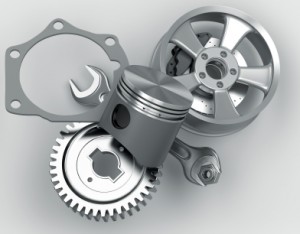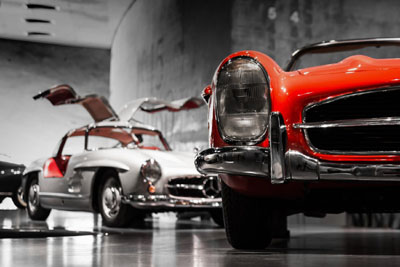You’ve had an accident. You’re okay, but your car is in need of some serious bodywork. Fortunately, you have auto insurance and you’ve already received a repair estimate from the claims adjuster.
That estimate notes covered repair costs for parts and labor, yes, but do you know which types of parts the body shop is being authorized to use?
A fender is a fender, right?
Not necessarily. Depending on the insurance company – and your level of coverage – you might be receiving either “original equipment” replacement parts (also called OEMs) made by the vehicle’s manufacturer, or components fabricated by a third party company, also called “aftermarket parts.”
OEM items are essentially the same body panels and other components used to originally build a vehicle, while aftermarket parts are engineered to be as identical as possible based on the same design specifications. Auto enthusiasts argue that there’s no substitute for OEM parts in terms of fit and finish, while insurance companies tend to prefer the use of aftermarket components as a cost-saving measure.
According to the National Association of Mutual Insurance Companies in Washington, D.C., aftermarket replacement parts are 26% to 50% less expensive than are original equipment components. They say that price differential helps carriers reduce auto insurance premiums by an estimated industry-wide $3.25 billion per year. The association says more than 95% of all insurance carriers specify use of aftermarket parts in at least some situations.
“Competition is the best form of consumer protection against excessive prices, and the vibrant aftermarket parts industry in this country has provided it for decades,” says Jimi Grande, senior vice president of federal and political affairs for NAMIC.
Proponents of aftermarket replacement components further argue that the quality is generally as good or better than OEM components, carry warranties that are often longer and are more widely available, which can mean a car can spend less time in the shop waiting for parts.
Either way, legislation in many states prohibits any surprises in this matter.
According to the Insurance Information Institute (III), 39 states mandate repair estimates identify when aftermarket parts are being used, while 13 require an owner to give consent prior to their being installed.
Specific provisions vary from one insurer to another, so be sure to check with an agent for details regarding reimbursement for OEM or alternative parts when shopping for a policy.
 Some carriers, including Liberty Mutual, will only pay for aftermarket replacement parts, while others, like Nationwide Insurance, allow policyholders to purchase additional coverage at a modest cost that ensures original equipment parts (where available) will be used. While State Farm pledges that “the final choice as to which parts will actually be used in repairs is left to the owner,” if a claimant’s parts preference jacks up the repair bill beyond the company’s estimate, he or she will be expected to pay the difference.
Some carriers, including Liberty Mutual, will only pay for aftermarket replacement parts, while others, like Nationwide Insurance, allow policyholders to purchase additional coverage at a modest cost that ensures original equipment parts (where available) will be used. While State Farm pledges that “the final choice as to which parts will actually be used in repairs is left to the owner,” if a claimant’s parts preference jacks up the repair bill beyond the company’s estimate, he or she will be expected to pay the difference.
Farmers Insurance pays for OEM parts, but only for policyholders with cars having less than 24,000 miles who additionally carry their extra-cost New Car Pledge Coverage. It also covers complete replacement of the vehicle, if totaled, at full market value without depreciation.
For its part, Allstate lets its customers decide which type of parts to use, but adds a twist to the decision. If the car is taken to one of Allstate’s 4,500 “Good Hands” direct repair program shops, CAPA certified after-market sheet metal parts will be specified, but the parts will be guaranteed for as long as the individual owns the car, compared to only 12 months with OEM parts.
“Allstate policyholders have options when it comes to settling their auto claims,” says company spokesperson April Eaton. “Our standard auto policy gives customers the ultimate say when it comes to the use of aftermarket or OEM parts.”













This is insane for the NAMIC to blame their use for aftermarket parts on saving $3B a year. Absolutely ludicrous. If people were TOLD they were having old parts added to their car, most would surely prefer to pay a bit more to have all new OEM parts added to their car. And you really think they are saving us a bunch of money on our premiums by using aftermarket/used parts?! Bullcrap! They are not cutting our premiums after this implementation, they are pocketing every penny and charging us the same as usual. This should absolutely be against the law. Probably a reason the auto industry has suffered in recent decades, to be honest. Maybe they should consider getting patents on every single part on a car, maybe even allowing manufacturers of complete cars to use the patent without paying a royalty. Just a thought. That way aftermarket parts couldn’t be produced and the insurance companies will have to go OEM no matter what. Wouldn’t used parts void a manufacturer warranty? I bet insurance companies don’t pick up the slack there, huh. Just outrageous. I mean, I’ll never drive a car under 10 years old because I’m not a sucker who takes on car loan debt, so I’ll probably never care much for used/aftermarket parts…unless we’re talking crash safety parts. I would hope that there’s a law to use brand new crash-safety parts at least. But knowing insurance companies, I doubt that. Tell you what, if a used part causes your next crash, I would sue sue sue! Take that giant settlement and retire early.